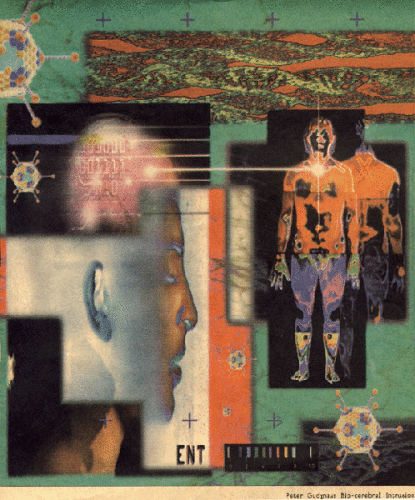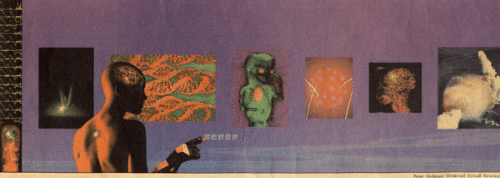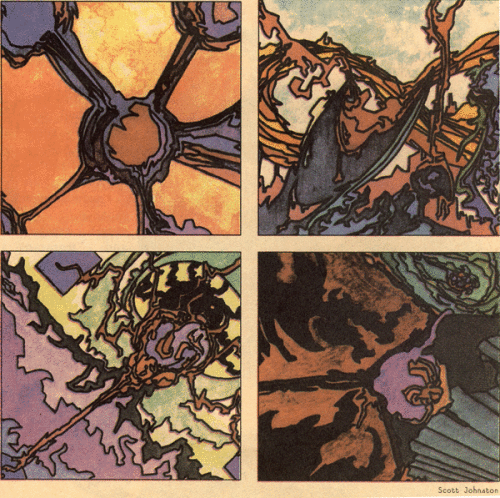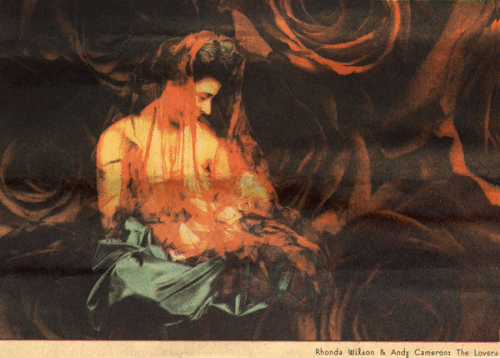Made in Birmingham
We never had Bird's Angel Delight when I was a kid because my Dad wouldn't eat it. He worked nights in the Digbeth factory where it was made, emptying two hundred-weight sacks of flour into vast hoppers. "If you saw what went into those hoppers along with the flour, you wouldn't eat it either," he used to tell me, hinting at ingredients such as human blood and bits of rat.
There are two reasons why this story is still interesting to me today. The first is that my Dad is a 100% genuine originator of an urban myth, a rare thing to be. And the second is that the factory in which he worked is no longer home to gloopy instant desserts but to some of the key people in Birmingham's thriving digital arts scene.
Now known, appropriately enough, simply as The Custard Factory, the historic building has been divided into units, many of which serve as artist's studios and installation spaces. It has gone some way to filling the gap left in Birmingham by the absence of space dedicated to modern visual arts: there is no ICA or Cornerhouse type venue in the city. The Factory hosts exhibitions and events - for example, last year's fax art show organised by Peter Fletcher & Jurgis Lugas, "021 693 6655" - and houses organisations such as Shooting Stills, a photography agency and gallery that generated the UK's first digital billboards (see below), and Seeing the Light (STL), a collaborative project aimed at promoting photography and digital imaging.

Image: Peter Gudynas, Bio-cerebral Intrusion
Out in Wolverhampton you can find the Lighthouse, the nearest thing the West Midlands has to a traditional media centre. Evelyn Wilson, Exhibitions and Events Co-ordinator at Lighthouse has been encouraging digital media into the centre's spaces over the last year and a half, the list of exhibited artists including Ming D-Nasty, Peter Gudynas and Cath Moonan, with Buggy G. Riphead opening a major exhibition there this October. And Jubilee Art in Sandwell have over twenty years experience in using new technology to help develop and strengthen community links. Their recent project "Sex get Serious" - an educational CD-Rom about sex and HIV - has put them in the media eye and, working in collaboration with the Birmingham Centre for Media Arts (BCMA), they have just won one of four nationally offered commission from CHANNEL (the Media Arts Network) to produce a piece of art to go out "live" on the Internet. They are also working with Sandwell Regeneration Partnership to set up a new "Centre for the Creative Use of Technology."
BCMA have been very much involved with setting up suitable resource nodes and running courses designed to introduce artists to digital media for some time now. Indeed, in July & August this year a successful exhibition ("New Worlds") was organised at the Midlands Arts Centre which focused specifically on the work of people who had come through these programmes. Rhonda Wilson of STL - whose training courses for using new technology will begin this autumn - explained to me that the central problem for Birmingham artists hoping to work with electronic and digital media has always been one of access, although this is gradually beginning to change.
Darian Systems, the company who recently wired up the Custard Factory (which now has its own service provider) also configured Birmingham's biggest cyber-caf, the Caf Surf (situated in the Arcadian centre), as well as the on-line terminal in the Sputnik bar in Temple Street. There are two other Internet cafs now up and running, one in the area of the cathedral and one on the Pershore road. This last is not a caf so much as a cyber-pizzeria, and apparently takes pizza orders over the World Wide Web; but whether you prefer cappuccino, Pellegrino or Quattro Formaggi with your super-highway the fact is that these venues have seriously alleviated the problem of access in the city.

Image: Peter Gudynas, Unmanned Virtual Re-entry
Birmingham is one of the last great unreformed GLC type cities, points out Simon Redgrave of Combustion Media, a loose Birmingham network involved in precipitating projects that cross-over between arts, media and education. Following the building of the Convention Centre with its Symphony Hall and other "international" facilities the plan of the council is to divide up the city into a series of rough "quarters", each with individual economies and interests of their own. Digbeth, where the Custard Factory resides, seems to have become the arts/media quarter, although according to Redgrave "as it is a good ten minutes walk from the 'main drag', it has tended to develop the rarefied air of an artists' colony, a bit like the island of Sark in the 1930's." One of the keynotes of this policy has been providing many new business with very cheap or even free space for their first year of trading. Although many of these ventures are folding after eighteen months, the wealth of new bars and underground outlets that have opened thanks to this opportunity has meant that Birmingham is now witness to the funkiest city centre scene it has seen in decades. "There's an incredible buzz in the whole city," says Sadie Plant, without whom no article on Birmingham arts would be complete. "I can't quite believe it's happening. And cyberculture is a key factor. The city seems to be moving round very much as a context for that. Moseley has always been trendy as Birmingham's Islington, but now the City Centre is blossoming and the north side of the city, around the old Jewellery Quarter where I live - which has always been particularly run down - is now becoming a focus too."
But we are not talking about a simple mimicry of the West Coast Cyberscene. After all, who could imagine anything as hippie dippy as the WELL, or as overoptimistic as Wired coming out of Brum? With the University of Warwick - home of Nick Land - becoming the national centre for viral thinking, and a strong two way traffic between Birmingham and Coventry (where the university is based) now as firmly in place as a PIPER feed, Midlands artists are beginning to realise that they have one of Europe's most powerful intellectual-creative axes in their backyard.
The new year will see the publication of an "anti-cultural studies cultural studies dictionary" by Switch, described by "involved person" Mark Fisher as "a virtual network, liminal between the academy and the arenas of art and music." And the past is not devoid of such projects either. The photography & arts magazine Ten-8 was one of the design publications of the late 80's and early 90's. Over a number of years Derek Bishton (now with the Electronic Telegraph) and the other founding editors (Mark Blackstock, Darryl Joe Georgiou & David A. Bailey) established an enviable reputation for Ten-8 as a premiere magazine bringing together image makers & critical theorists and showcasing the work of photographers and photo-artists throughout the Midlands region and beyond. The early '90s saw Ten-8 metamorphose into book form, producing seminal issues "Critical Decade", now a CDi, and "Digital Dialogues", a comprehensive overview of the burgeoning impact of digital media and how it was changing the nature and reputation of photography as a medium of representation.
Peter Gudynas, a freelance graphic artist and designer whose credits include cover art for J.G.Ballard and Pat Cadigan, has had a strong presence in the Midlands for many years. In 1988 he, his brother Bernard, and Jurgis Lugas formed the independent electronic arts collective Zap Art International. Now based in Stoke Newington, Zap Art took a very irreverent post dada, techno pop, trash art approach to their exhibitions and quickly carved a reputation for themselves with work for London's infamous Brain club at the height of the acid house boom, shows at the Alexandra Palace London (1991) and the F-stop photography gallery in Bath (1993), as well as installations at the Midlands Arts Centre (1992) and the Goate Gallery Birmingham (1992). Last winter Gudynas held a major retrospective - "Post-human Photo fictions" - at the Lighthouse. And during summer 1994 Gudynas' commissioned work "Made in Birmingham" - a piece featuring the juxtaposition of a heart, a car production line, and the vast spaghetti junction - adorned a large billboard in the Jewellery Quarter. The display was one of three sponsored by ICL of Stirchley (the other two featured artists Mark Taylor & Claudette Holmes). Words accompanying Gudynas's image read: "A post industrial heart-landscape of arterial roads, intersections and bypasses - cerebral interchange. The confusion of a city lost in transition from one age to another, post-industrial to technological new age. The old city is changing."

Image: Scott Johnston
Darryl Georgiou regards spaghetti junction as the ultimate symbol of the city, and one which in the new climate need no longer be seen as negative: "Everyone's been through Birmingham, but no one's been to it. Spaghetti junction is what most people associate with Central England; from New Street station you can reach most places in the country within an hour and a half. This kind of connectivity has in the past brought with it a huge identity crisis. But with new technology your delivery platform can be anywhere, networks are replacing centralised institutions, and suddenly to have had such an identity crisis is a positively enabling thing." Sadie Plant comments: "If once it seemed that everything was made in Birmingham, the future brings no such guarantees. Together with all the old centres and black countries of the old white world, the Midlands are subsumed by migrations to the oceanic periphery: industry loses weight, hardware softens up, road systems melt into digital highways, and the city of routes and a thousand trades meets the virtual plateau. But the generations whose parents worked on the lathes and assembly line of the past are now those turning the future on."
These Birmingham generations include artists such as Keith Piper, one of Britain's most successful multi-media artists; Steve Pochin, Nancy Flint & Peter Worrall, early contributors to Zap Art and now with a considerable reputations of their own; Andy Saxon and David Miles, both image makers who operate out of the University of Central England; Andy Cameron, a designer & artist with close links to Ten-8; Rhonda Wilson of STL, an artist in her own right; Ming D-Nasty, who creates images which explore women's experience of the new technological forms; and Scott Johnston, who melds digital imagery with Birmingham's fine tradition of comic art, evoking the former with techniques developed from the latter, and who recently exhibited at the Electric Cinema.
The Midlands is also developing a strong reputation for cutting edge multi-media events. "The thing about Birmingham," says Pervaiz Khan of Digital Equinox, an offshoot of the Afro-Caribbean empowerment project DRUM, "is that here's the city of the industrial revolution which at the end of the twentieth century has ended up with the highest proportion of black people of any urban space in Britain. There is far more interaction between black and white here, not because there's any particular awareness or access to 'identity politics', but because there simply isn't the space to segregate. And it was this which meant that the city could produce Steel Pulse in the '70s, UB40 in the '80s and Apache Indian in the '90s ' " Simon & Diamond, cousins of Apache Indian and producers of his first album, were involved at an event staged at the Custard factory by Digital Equinox back in March. Gary Stewart (of London's ARTEC) was responsible for integrating all the aspects of the two-day live arts event which "came out of the desire to create an opportunity using film, technology, video and music to have a public jam session - a real multi-media event," according to Khan. "All the media went onto video and through AVID photoshop to create a full digital palette that people could use." The two night show featured work by Shila Buman, the photocopy artist, and Trevor Mathieson & Eddie George of the Black Film and Video Collective; a second Digital Equinox event is taking place on December the 2nd at Moseley Dance Centre.

Image: Rhonda Wilson and Andy Cameron, The Lovers
The latest wave of Midlands artists are finding expression in the forums provided by the club nights that are springing up in and around the city. Bands such as Black Dog and Ultramarine have already received nation-wide recognition; House of God, Atomic Jam, the Bubble Club, Space Hopper & Third Eye are all successful collaborations that regularly do nights at Birmingham's Q-club; The Circus in Balsall Heath carries what are regarded as amongst the best jungle nights in the country. According to Lisa Schrevel, club punter extraordinaire, the scene has evolved on the basis of club nights rather than clubs. "Birmingham licensing laws have traditionally been very strict, and it's only in the last year that anything going past 2am has really begun to happen. But the Q-club now attracts 1500 to 2000 people on a Saturday night." One of the most popular nights at the Q-club is organised roughly once a month by Oscillate. "Oscillate is more of a performance event than a night club," says Schrevel. "It's a social zone as much as a dance zone - and this is indicative of what's happening in Birmingham, pushing at the boundaries of what a club is." An Oscillate night always features a couple of live electronic acts, music by resident DJ's the Higher Intelligence Agency
and lights by Fossett, a theatre lighting technician turned club artist; but you might also find the sound sculptures of Johnny Easterby, or the video and animation of Cloud 23. Magda, an Oscillate prime mover, remarks that this is more than a few funky hangings and a strobe. "We are trying to get away from that. And while everyone dances the music is a gentler groove than you'll find elsewhere - but it's not ambient."
It's these kind of artist led initiatives that are making Birmingham a special place to be. Even some of the Regional Arts Boards are now beginning to acknowledge the role of clubs in promoting new work; people who would never set foot in the Ikon gallery (Birmingham's equivalent of the ICA) will pay money to visit these "time-based gallery spaces" where new art is always on display.

"Birmingham is traditionally very apolitical. It's good at the pragmatic, commercial side of things rather than the ideological. And it's also very unghettoised. Quite unlike Manchester, for example, where the gay village, Chinatown and so on are very much islands turned in towards themselves. That Birmingham is not like this makes it an all the more vibrant place to be." This is Sadie Plant's view, and it is interesting to note her attitudes alongside the fear of Simon Redgrave that the one thing endangering this recent Midlands boom is the chance that the various quarters of the city might cease to communicate with each other. At the moment, he says, "most of the writers / artists / creators tend to know each other, or of each other, and a great deal of networking goes on. There is, it seems to me, a co-operative rather than a competitive spirit, with an absence of egos to contend with. This comes about, I think, at having all been in at the start of something that is only now becoming recognised, and having faced similar problems along the way. Birmingham regenerate itself all around is as good a metaphor for this as any."
I'd like to thank all those mentioned in the article, as well as many more who did not get a credit, for all your time and effort in helping me research this article. Power to the Midlands - I hope I've done you justice.
Rhonda Wilson can be reached on <stl AT custard.co.uk> ;
Zap Art at <Zap-Art AT cityscape.co.uk> ;
Mute Books Orders
For Mute Books distribution contact Anagram Books
contact@anagrambooks.com
For online purchases visit anagrambooks.com






